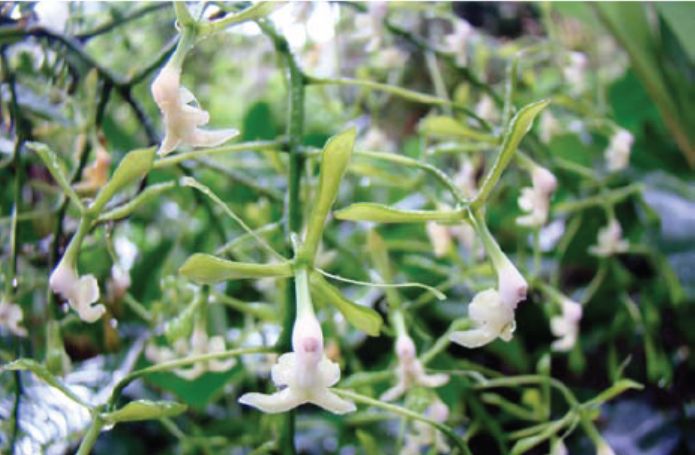

Epidendrum paniculourubambense Hágsater et E.Santiago 2013 GROUP Pseudepidendrum SUBGROUP Paniculatum
Photo by © Eric Hagsater
TYPE Drawing by © Jimenez, Hágsater & E.Santiago and The AMO Herbario Website



 THROUGH MID
THROUGH MID 
Common Name The Paniculate-Urubamba Epidendrum [refers to this species of the Paniculatum Subgroup, and commonly known from the Urubamba valley in Peru]
Flower Size .8" [2 cm]
Found in southern Peru on clay banks in wet montane forests at elevations of [1350] 1800 to 2800 meters as a giant sized, cool to cold growing terrestrial with a simple, canelike, erect, terete stem carrying 20 or more, subcoriaceous, alternate, articulate, narrowly elliptic, acuminate, margin entire leaves that blooms in the summer through mid fall on a terminal, paniculate, flowering only once, a large, branching panicle, with up to 10, spreading, lax, many-flowered branches 4.8 to 6.8" [12 to 17 cm] long, each branch with a basal narrowly triangular, acuminate, amplexicaul bract, peduncle .8 to 4.8" [2 to 12 cm] long, straight, thin, provided with up to 5 tubular, acuminate, partly imbricating bracts, 12 to 16" [30 to 40 cm] long, simultaneously to 110 flowered inflorescence with small, much shorter than the ovary, linear-lanceolate, acuminate, amplexicaul floral bracts and carrying resupinte flowers.
"Epidendrum paniculourubambense belongs to the GROUP Pseudepidendrum which is characterized by caespitose plants, cane-like stems, acute to acuminate leaves, usually apical inflorescence, the mostly filiform petals and the lip usually 3-lobed with 3 parallel fleshy keels, the apical lobe often bifurcate, the “bird-wing” type pollinia, at least the inner pair, and SUBGROUP Paniculatum , which has filiform petals, all pollinia “bird-wing” type, green and white flowers, often marked with purple on the disc of the lip and apex of the column. The species is recognized by the tall plants, up to 100" [2.5 meters] tall, with a large, many-branched, lax-flowered panicle, the flowers are green with the lip and apical half of the column immaculate white, sepals .56 to .64" [14 to 16 mm] long, ovary scarcely pubescent, and the lip with a deeply emarginated mid-lobe, forming two long, divaricate, falcate apically narrowly rounded lobes, and the width of the lip between the lateral lobes about 2/3 compared to the width between the apices of the lobes of the mid-lobe. It is very similar to Epidendrum floribundum Kunth which has smaller flowers, sepals .42" [10.5 mm] long, unornamented ovary, and the mid-lobe of the lip bilobed (not emarginate), which are strongly divaricate, the two lobes forming a right angle. Epidendrum paniculatum Ruiz & Pav. has smaller plants, sepals .48 to .52" [12-13 mm] long, the flowers green with the lip and apical half of the column white, and the disc, tinged with red, the width of the lip between the lateral lobes nearly as wide as between the lobes of the mid-lobe" Hagsater etal 2013
Synonyms
References W3 Tropicos, Kew Monocot list , IPNI ; Icones Orchidacearum 14 Plate 1468 Hagsater & Sanchez 2013 see recognition section; Icones Orchidacearum 14 Plate 1469 Hagsater & Sanchez 2013 see recognition section; * Icones Orchidacearum 14 plate 1470 Hagsater & Sanchez 2013 drawing fide;
--------------------------------------------------------------------------------------------------------------------------